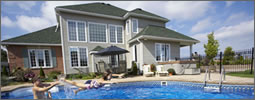Concrete siding is often thought to be synonymous with fiber cement calding, it can actually refer to a variety of cladding materials such as stucco, concrete boards, mortarless masonry or brick veneer. Any of these options make for excellent cladding due to the fact that they are fire retardent, mildew, rot and insect proof, as well as requiring little to no maintenance.


Concrete Siding Prices
Entry To Mid Level: $5.00 – $7.50 psf
Consumers can expect to spend anywhere from $500 to $750 per square installed.
Mid To High End: $7.50 – $10 psf
Consumers can expect to spend anywhere from $750 to $1,000 per square installed.
Learn more on concrete siding cost.

Concrete Board Siding
Actual concrete board siding is a substrate or underlying material that is used when hanging or applying other concrete cladding to a home. It is an aggregate of Portland cement that can be used for many different purposes. On application is with EIF or external insulation finish, which is a composite stucco that is sometimes used in place of stucco.

Stucco
With the exception of fiber cement, stucco is the most popular and widely used cladding that is similar to concrete siding. Stucco is a cement based amalgam that is applied to a lathe base. It is many advantages, including being highly insect, mildew and weather resistant. It lasts for a long time, is available in many colors and textures looks quite attractive (especially on spanish style homes).

Stone and Brick Veneer
Stone and brick veneer is a relatively new and exciting cladding alternative. They are made from an amalgam of Portland cement, pigments and other natural additives. The mix is then poured into molds, which replicate natural stone or brick face, but much more lightweight. The advantages are easy installation, less reinforcements due to the lightweight material and a much better price point. Combine this with the advantages of concrete siding and the appeal is obvious. The downside is that entry level and some mid grade options do not look very authentic.

Mortarless Masonry
Mortarless masonry is used in many new construction for commercial buildings and application. The large concrete stones or bricks are created in molds and fit together without mortar. The bricks lay on top of one another just like traditional bricks. They are much cheaper to install because there is no need to mortar, which is a slow and time consuming process. It has all the same properties as other concrete siding and creates a gentle, textured appearance.
Related Topics
Brick
Brick Veneer
Concrete Logs
Stucco



